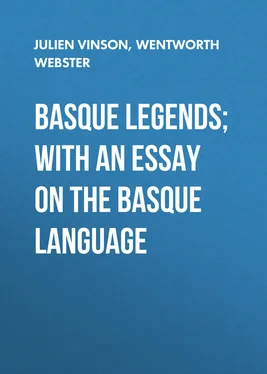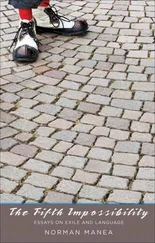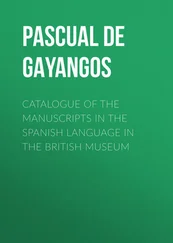Julien Vinson - Basque Legends; With an Essay on the Basque Language
Здесь есть возможность читать онлайн «Julien Vinson - Basque Legends; With an Essay on the Basque Language» — ознакомительный отрывок электронной книги совершенно бесплатно, а после прочтения отрывка купить полную версию. В некоторых случаях можно слушать аудио, скачать через торрент в формате fb2 и присутствует краткое содержание. Жанр: foreign_antique, Старинная литература, Мифы. Легенды. Эпос, на английском языке. Описание произведения, (предисловие) а так же отзывы посетителей доступны на портале библиотеки ЛибКат.
- Название:Basque Legends; With an Essay on the Basque Language
- Автор:
- Жанр:
- Год:неизвестен
- ISBN:нет данных
- Рейтинг книги:3 / 5. Голосов: 1
-
Избранное:Добавить в избранное
- Отзывы:
-
Ваша оценка:
- 60
- 1
- 2
- 3
- 4
- 5
Basque Legends; With an Essay on the Basque Language: краткое содержание, описание и аннотация
Предлагаем к чтению аннотацию, описание, краткое содержание или предисловие (зависит от того, что написал сам автор книги «Basque Legends; With an Essay on the Basque Language»). Если вы не нашли необходимую информацию о книге — напишите в комментариях, мы постараемся отыскать её.
Basque Legends; With an Essay on the Basque Language — читать онлайн ознакомительный отрывок
Ниже представлен текст книги, разбитый по страницам. Система сохранения места последней прочитанной страницы, позволяет с удобством читать онлайн бесплатно книгу «Basque Legends; With an Essay on the Basque Language», без необходимости каждый раз заново искать на чём Вы остановились. Поставьте закладку, и сможете в любой момент перейти на страницу, на которой закончили чтение.
Интервал:
Закладка:
“It seems that you say you can get the Tartaro’s diamond?”
“I certainly did not say any such thing.”
“Yes, yes—you said it.”
“No, no! I did not say it; but I will try, if you give me all I shall ask for.”
And he asks for a great deal of money.
He goes off, and reaches the ferry, and pays the ferryman well, and goes far, far, far away into the forest, till he gets to the house of the Tartaro. The old woman tells him to be off from there; and he goes and hides himself again in the ferns. And he stops there until the Tartaro comes to the house, just as he did the first time. He turns over nearly all the ferns, and leaves him scarcely covered. He stops quietly there all the time that the Tartaro was having his huge supper, and when he thinks he has finished, and is taking his nap, he creeps out very, very gently. The Tartaro always put his diamond under his pillow, and he takes it away without waking him, and escapes, running off as fast as if to break his feet. The ferryman is there, and he crosses him over, and he pays him well. The Tartaro appears on the other side again, and calls out to him telling him to give him back his diamond, and that he would give him all that he could wish for. He answers, “No, no!” and runs on to the king’s house.
When he arrived there, the king did not know what to do. One feasted him, and another feasted him, and all the world was busied about him, and everyone loved him more and more, and the princess as well as the rest. The wicked prince did not know what to think of it. He was eaten up with jealousy, and he thought of something else, and said to the king:
“Petit Perroquet says that he can bring the Tartaro himself.”
The king sends for Petit Perroquet, and says to him:
“It appears that you have said that you will bring the Tartaro himself here.”
“No, no, no, I did not say anything at all like that; but if you will give me all I ask for, I will try. You must have a carriage made of iron, half-a-yard thick, and three horses to draw it, and lots of money. When all that is ready, I will set out.”
He asks, also, for a barrel of honey, another of feathers, and two horns, and starts off.
When he comes to the ferry, it was no easy thing to get this carriage into the boat. When he has got to the other side, he first puts himself into the barrel of honey, and then into the barrel of feathers, and ties the horns on to his head, and then mounts as postilion. He then comes to the Tartaro’s house, and just then he happened to be at home. Petit Perroquet knocks at the door. The Tartaro himself comes to open, and asks:
“Who are you? You!”
“I!!—I am the oldest of all the devils in hell.”
He opens the carriage door for him, and says:
“Get in there.”
The Tartaro gets in, and Petit Perroquet, very glad, starts off, and arrives at the ferry. He crosses, as he best can, with his carriage and horses. He pays the ferryman generously, and comes to the king’s palace. They were all terrified when they saw that he had the Tartaro there. They tried to shoot him with cannon, but he caught the bullets, and sent them back as if they had been balls to play with. They could not kill him in that way, so they finished him with other arms.
As Petit Perroquet had well gained her, they gave him the princess in marriage. He sent for his mother to the court, and as they lived well, so they died happily.
Pierre Bertrand.
II—The Heren-Suge.—The Seven-Headed Serpent
It would only be spoiling good work by bad to attempt to re-write the exhaustive essay which appears, under the heading of “St. George,” in Baring Gould’s “Curious Myths of the Middle Ages.” He there traces the atmospheric myth in which the Dragon is the storm-cloud, the Maiden the earth, and the Hero the sun, through all the forms of the great Aryan legend, in Indian, Egyptian, Phœnician, Italic, Keltic, Teutonic, and Scandinavian mythology. He shows that it was merely by a mistaken metaphor 20 20 One of the oddest instances of mistaken metaphors that we know of occurs in “La Vie de St. Savin, par J. Abbadie, Curé de la Paroisse” (Tarbes, 1861). We translate from the Latin, which is given in a note:—“Intoxicated with divine love, he was keeping vigil according to his custom, and when he could not find a light elsewhere, he gave light to his eyes from the light that was in his breast. The small piece of wax-taper thus lit passed the whole night till morning without being extinguished.”—Off. S. Savin.
that St. George came to assume the place, and wear the glories of the solar hero; and that England only followed in the wake of other countries, in making him her national Saint and Patron.
We will, therefore, now only glance at some of the Basque and Pyrenean forms of this wide-spread myth. M. Cerquand boldly places one form of the story, which is attached to the house of Belzunce, among historical legends. But the history of Belzunce and the Dragon stands in the same relation to the original myth as does that of Guy, Earl of Warwick, Moor of Moor Hall, and of scores of other heroes. In a Basque version, collected by ourselves, the concluding words show that in this form it is simply an Eponymous legend, to account for the name, “and that is whence comes the name of Belzunce.” The oldest Pyrenean version with which we are acquainted is that of the “Serpent d’Isabit.” We give the outlines of it from memory, as we heard, and read it, at Bagnères de Bigorre.
The serpent lay with his head resting on the summit of the Pic du Midi de Bigorre, his neck stretched down towards Barèges, while his body filled the whole valley of Luz, St. Sauveur, and Gédres, and his tail was coiled in the hollow below the cirque of Gavarnie. He fed but once in three months, or the whole country would have been desolate. With a strong inspiration of his breath, he drew into his capacious maw, across the valleys, whole flocks of sheep and goats, herds of oxen, men, women, children, the population of whole villages at once. He was now asleep, and inert, after such a repast. The whole male population of several valleys assembled to consult on what should be done. After long and fruitless debate an old man arose and spoke:—“We have nearly three months yet before he will wake; let us cut down all the forests on the opposite hills; then let us bring all our forges and all the iron we possess, and with the wood thus cut down let us melt it all into one red-hot fiery mass; then we will hide ourselves behind the rocks, and make all the noise we can to try and awaken the monster.” So said, so done. The serpent awoke in a rage at having his slumbers broken, he saw something bright on the opposite side of the valley, and drew in a long breath, and the fiery mass, with a roar like a thunderbolt, flew across the valley, right down the monster’s throat. Then, what convulsions ensued; rocks were uptorn or split open, the mountains were shattered, the glaciers beaten into dust as the serpent twisted and lashed about in his agony. To quench his agony of thirst he descended to the valley, and drank up all the streams from Gavarnie to Pierrefitte. Then, in his last convulsion, he threw himself back upon the mountain side and expired; his head rested in a deep hollow; as the fire within him slowly cooled, the water he had swallowed poured out of his mouth, and formed the present Lac d’Isabit. In M. Cerquand’s legend of the Dragon d’Alçay, the red-hot iron is replaced by “a cow’s skin full of gunpowder.” In all the Basque legends of this class the hero dies.
But these legends differ widely from the following tales; there is in them no princess to be rescued, no charcoal-burner, no marriage, or any other wonders. Were it not for their still closer resemblance to the Gaelic tales, we should suspect the following legends to be simply translations of some French legend of St. George. As we remarked before, like the Deccan cobras, the Heren-Suge is always seven-headed. It is strange, too, to notice that the princess always behaves in the same chivalrous way. “One is enough to die.” The union, too, of Tartaro and Heren-Suge in the same tale is curious.
Читать дальшеИнтервал:
Закладка:
Похожие книги на «Basque Legends; With an Essay on the Basque Language»
Представляем Вашему вниманию похожие книги на «Basque Legends; With an Essay on the Basque Language» списком для выбора. Мы отобрали схожую по названию и смыслу литературу в надежде предоставить читателям больше вариантов отыскать новые, интересные, ещё непрочитанные произведения.
Обсуждение, отзывы о книге «Basque Legends; With an Essay on the Basque Language» и просто собственные мнения читателей. Оставьте ваши комментарии, напишите, что Вы думаете о произведении, его смысле или главных героях. Укажите что конкретно понравилось, а что нет, и почему Вы так считаете.












